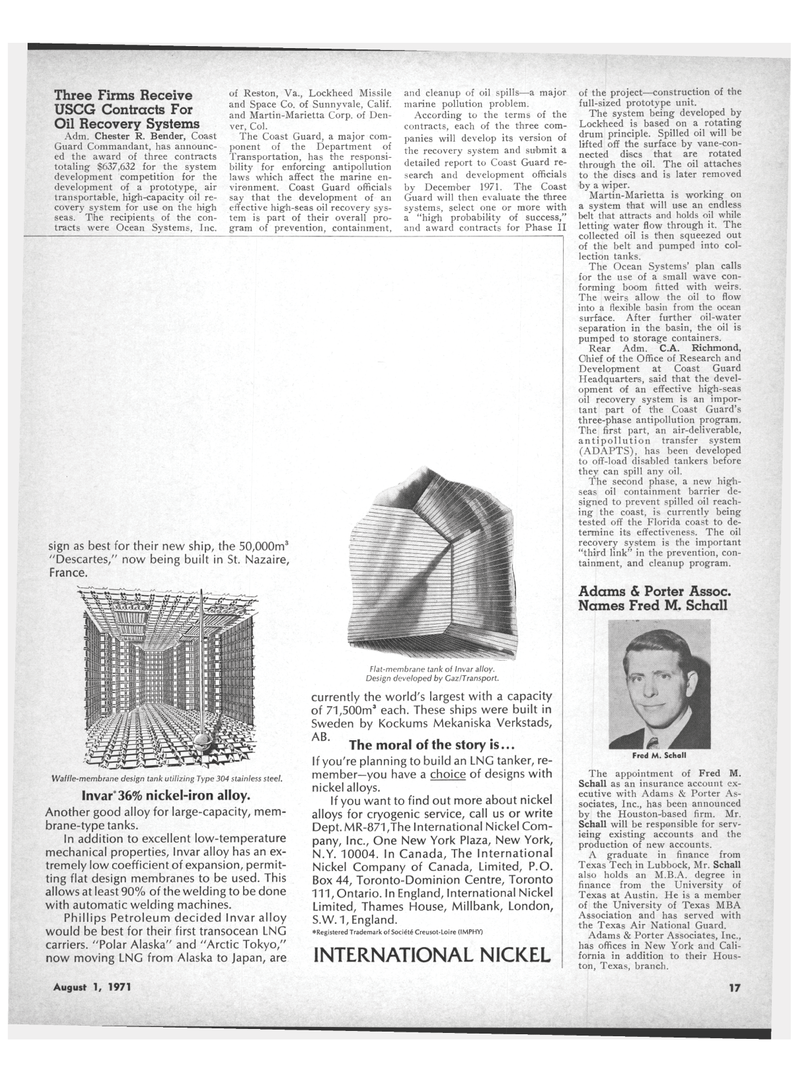
Page 15: of Maritime Reporter Magazine (August 1971)
Read this page in Pdf, Flash or Html5 edition of August 1971 Maritime Reporter Magazine
Three Firms Receive
USCG Contracts For
Oil Recovery Systems
Adm. Chester R. Bender, Coast
Guard Commandant, has announc- ed the award of three contracts totaling $637,632 for the system development competition for the development of a prototype, air transportable, high-capacity oil re- covery system for use on the high seas. The recipients of the con- tracts were Ocean Systems, Inc. of Reston, Va., Lockheed Missile and Space Co. of Sunnyvale, Calif, and Martin-Marietta Corp. of Den- ver, Col.
The Coast Guard, a major com- ponent of the Department of
Transportation, has the responsi- bility for enforcing antipollution laws which affect the marine en- vironment. Coast Guard officials say that the development of an effective high-seas oil recovery sys- tem is part of their overall pro- gram of prevention, containment, and cleanup of oil spills—a major marine pollution problem.
According to the terms of the contracts, each of the three com- panies will develop its version of the recovery system and submit a detailed report to Coast Guard re- search and development officials by December 1971. The Coast
Guard will then evaluate the three systems, select one or more with a "high probability of success," and award contracts for Phase II of the project—construction of the full-sized prototype unit.
The system being developed by
Lockheed is based on a rotating drum principle. Spilled oil will be lifted off the surface by vane-con- nected discs that are rotated through the oil. The oil attaches to the discs and is later removed by a wiper.
Martin-Marietta is working on a system that will use an endless belt that attracts and holds oil while letting water flow through it. The collected oil is then squeezed out of the belt and pumped into col- lection tanks.
The Ocean Systems' plan calls for the use of a small wave con- forming boom fitted with weirs.
The weirs allow the oil to flow into a flexible basin from the ocean surface. After further oil-water separation in the basin, the oil is pumped to storage containers.
Rear Adm. C.A. Richmond,
Chief of the Office of Research and
Development at Coast Guard
Headquarters, said that the devel- opment of an effective high-seas oil recovery system is an impor- tant part of the Coast Guard's three-phase antipollution program.
The first part, an air-deliverable, antipollution transfer system (ADAPTS), has been developed to off-load disabled tankers before they can spill any oil.
The second phase, a new high- seas oil containment barrier de- signed to prevent spilled oil reach- ing the coast, is currently being tested off the Florida coast to de- termine its effectiveness. The oil recovery system is the important "third link" in the prevention, con- tainment, and cleanup program.
Adams & Porter Assoc.
Names Fred M. Schall
Fred M. Schall
The appointment of Fred M.
Schall as an insurance account ex- ecutive with Adams & Porter As- sociates, Inc., has been announced by the Houston-based firm. Mr.
Schall will be responsible for serv- icing existing accounts and the production of new accounts.
A graduate in finance from
Texas Tech in Lubbock, Mr. Schall also holds an M.B.A. degree in finance from the University of
Texas at Austin. He is a member of the University of Texas MBA
Association and has served with the Texas Air National Guard.
Adams & Porter Associates, Inc., has offices in New York and Cali- fornia in addition to their Hous- ton, Texas, branch. sign as best for their new ship, the 50,000m3 "Descartes," now being built in St. Nazaire,
France.
Waffle-membrane design tank utilizing Type 304 stainless steel.
Invar*36% nickel-iron alloy.
Another good alloy for large-capacity, mem- brane-type tanks.
In addition to excellent low-temperature mechanical properties, Invar alloy has an ex- tremely low coefficient of expansion, permit- ting flat design membranes to be used. This allows at least 90% of the welding to be done with automatic welding machines.
Phillips Petroleum decided Invar alloy would be best for their first transocean LNG carriers. "Polar Alaska" and "Arctic Tokyo," now moving LNG from Alaska to Japan, are
Flat-membrane tank of Invar alloy.
Design developed by Caz/Transport. currently the world's largest with a capacity of 71,500m3 each. These ships were built in
Sweden by Kockums Mekaniska Verkstads,
AB The moral of the story is...
If you're planning to build an LNG tanker, re- member—you have a choice of designs with nickel alloys.
If you want to find out more about nickel alloys for cryogenic service, call us or write
Dept. MR-871,The International Nickel Com- pany, Inc., One New York Plaza, New York,
N.Y. 10004. In Canada, The International
Nickel Company of Canada, Limited, P.O.
Box 44, Toronto-Dominion Centre, Toronto 111, Ontario. In England, International Nickel
Limited, Thames House, Millbank, London,
S.W.1, England. • Registered Trademark of Soci£t£ Creusot-Loire (IMPHY)
INTERNATIONAL NICKEL
August1 1, 1971 17

 14
14

 16
16
